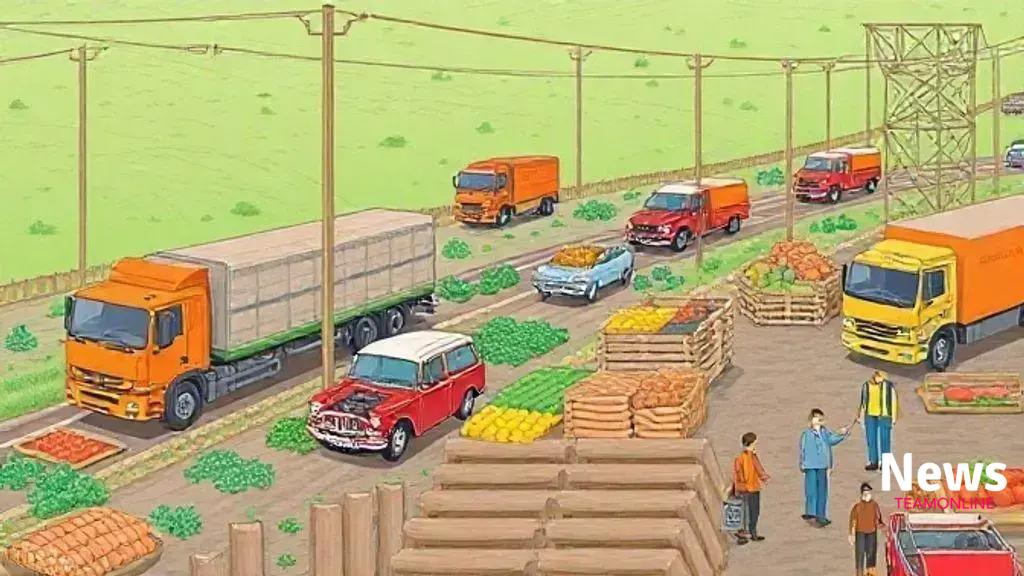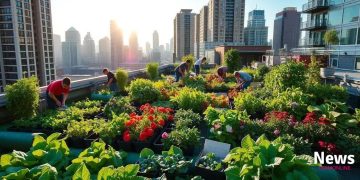Food supply chain policy: what you need to know

Food supply chain policy encompasses regulations and practices that ensure food safety, sustainability, and efficiency from production to consumption, influenced by technology and consumer demand.
When we talk about food supply chain policy, it encompasses all the rules and guidelines governing how food travels from farms to consumers. Have you ever thought about how these policies impact your daily meals?
Understanding food supply chain policy
Understanding food supply chain policy is crucial for anyone interested in how food moves from producers to consumers. It involves various regulations and practices that ensure safe and efficient distribution of food products.
The policy addresses multiple aspects, including safety standards, transportation logistics, and economic factors affecting food prices. Each element plays a vital role in the overall efficiency of the food system.
Key Elements of Food Supply Chain Policy
There are several key components that are examined within food supply chain policy. These include:
- Food safety standards: Regulations that ensure food is safe for consumption, minimizing risks of contamination.
- Transportation logistics: Guidelines that govern how food is transported, including temperature controls and timing.
- Economic policies: These influence prices and access to food for consumers.
- Sustainability measures: Strategies aimed at reducing the environmental impact of food production and distribution.
The interaction between these elements can significantly impact how efficiently food reaches our tables. For example, transportation logistics must coordinate with food safety standards to ensure that perishable items are delivered promptly and safely.
Additionally, changes in economic policies can affect food supply availability, impacting both producers and consumers. It is important to stay informed about these policies as they evolve.
The Importance of Awareness
Having a clear understanding of food supply chain policy not only informs consumers about food availability but also helps them make educated choices regarding their purchases. The better we understand these policies, the more empowered we are as consumers.
By recognizing the complexities of the food system, we can appreciate the importance of supporting local producers and sustainable practices. As consumers, being informed about where our food comes from and how it’s regulated can lead to more responsible choices.
Key components of an effective policy
Several key components are vital for creating an effective food supply chain policy. These components ensure the smooth operation and regulation of how food reaches consumers.
One major aspect is the establishment of food safety standards. These standards outline the necessary practices that keep food safe for public consumption. They include guidelines on hygiene, handling, and processing, crucial for minimizing contamination risks.
Regulatory Compliance
Another important component is regulatory compliance. Businesses involved in the food supply chain must adhere to local, national, and international laws. Compliance not only promotes public health but also fosters consumer trust.
- It ensures that food products are produced in safe environments.
- Compliance helps avoid legal issues and fines.
- It can enhance a company’s reputation with customers.
- Regulatory aspects support transparency in sourcing and production.
Additionally, the implementation of sustainability measures is crucial. These measures aim to reduce the environmental impact of food production, including energy consumption and waste management practices.
Efficient transportation logistics also play a significant role. They dictate how food moves from producers to retailers and ultimately to consumers. Proper logistics ensure timely deliveries while maintaining food quality. Effective transportation systems minimize delays and preserve freshness.
Economic Considerations
Economic considerations form another pillar of effective policy. Changes in trade regulations or tariffs can affect food prices and availability. It is essential to analyze how these economic factors influence the overall food supply and access to it.
Public and private partnerships can strengthen food supply chain policy by combining resources and expertise. Collaboration among stakeholders fosters innovation and leads to better solutions for challenges faced in the food system.
The role of technology in food supply chains

The role of technology in food supply chains is essential for enhancing efficiency and transparency. Technology helps streamline processes, making food distribution faster and safer.
One significant advancement is the use of automation. Automated systems can manage inventory, track shipments, and optimize routes for delivery. This means that food reaches consumers more quickly and with less waste.
Data Analytics
Data analytics plays a pivotal role in understanding trends within the food supply chain. By analyzing consumer behavior and demand patterns, businesses can make informed decisions about production and distribution. This proactive approach can lead to:
- Better inventory management, reducing excess stock.
- More accurate forecasting of food demand.
- Enhanced quality control by identifying potential issues early.
- Informed choices about sustainable sourcing methods.
Moreover, technology such as Blockchain offers traceability in food production. With every transaction recorded, consumers can track the origins of their food. This transparency builds trust between producers and consumers.
The implementation of smart sensors is another game changer. These sensors monitor environmental conditions during transportation. They help ensure that food is kept at the right temperature and humidity levels, preserving quality.
Connecting Farmers and Consumers
Online platforms also connect farmers directly with consumers. This reduces the number of intermediaries, allowing farmers to earn more while offering consumers fresher produce. Such platforms create a community that values quality and sustainability, encouraging better practices in food production.
Leveraging mobile technology allows consumers to access information easily. Apps can provide details about food sourcing, nutritional information, and even recipes based on what’s in season. In this way, technology not only improves logistics but also empowers consumers with knowledge.
Challenges faced in supply chain management
Challenges faced in supply chain management can impact the efficiency of food delivery. A variety of factors can disrupt the flow of goods from producers to consumers.
One major challenge is the issue of food safety. With the increasing complexity of global supply chains, ensuring the safety of food products becomes more difficult. Contamination can occur at any point, making strict safety standards essential.
Logistical Hurdles
Logistics also present significant challenges. Transportation delays can arise from traffic issues, poor infrastructure, or unexpected weather conditions. These delays often result in spoilage and increased costs. Addressing these logistical hurdles requires careful planning and real-time data monitoring.
- Supplier reliability: Unreliable suppliers can cause disruptions in the supply chain.
- Inventory management: Poor inventory control leads to either shortages or excess stock.
- Communication gaps: Lack of communication between stakeholders can create misinformation and slow response times.
- Regulatory compliance: Keeping up with changing regulations can be costly and time-consuming.
Another challenge is managing consumer demand. Fluctuations in demand can make it hard to adjust supply accordingly. If the supply chain cannot respond quickly to changes, it can result in both waste and missed sales opportunities.
Additionally, environmental factors, such as climate change, pose risks to supply chains. Changes in weather patterns can affect crop yields and agricultural practices. This unpredictability further complicates supply planning and sustainability efforts.
Technological Adaptation
Adopting new technologies can be daunting for many businesses. Resistance to change can hinder process improvements. However, investing in technologies, like automation and data analytics, can help address many supply chain challenges.
Finally, the recent pandemic highlighted vulnerabilities in supply chains. It showed how interconnected systems could lead to widespread disruptions. These challenges serve as a reminder that understanding and addressing potential risks is crucial for maintaining a resilient supply chain.
Future trends in food supply chain policy
Future trends in food supply chain policy are evolving to meet the demands of a changing world. As consumer awareness and technological advancements grow, policies must adapt to keep pace.
One significant trend is the increasing emphasis on sustainability. Policymakers are recognizing the need for environmentally friendly practices in food production and distribution. This shift focuses on reducing waste, conserving resources, and promoting sustainable farming techniques.
Technology Integration
Another trend is the greater integration of technology in supply chain management. As technologies like blockchain and artificial intelligence continue to develop, they offer new ways to enhance transparency and efficiency. These technologies can track food products from farm to table, ensuring safety and quality.
- Real-time data monitoring: This helps stakeholders make informed decisions quickly.
- Automation: Automating processes can reduce labor costs and improve accuracy.
- Online platforms: Connecting consumers directly with producers encourages local buying.
- Smart farming: Techniques that use data analytics to optimize crop yields and resource use.
Additionally, consumers are becoming more engaged in food sourcing. They want to know where their food comes from and how it is produced. This trend pressures companies to be transparent about their practices and adhere to ethical standards.
Moreover, policies are likely to focus on food security. Climate change and global uncertainties pose risks to food supplies. As a response, governments may develop strategies to ensure a stable food supply, including support for local farmers and investments in innovative farming methods.
Regulatory Changes
Finally, regulatory changes will likely address health and safety in the food supply chain. Expect policies that promote better nutrition and minimize health risks. These could include stricter food safety regulations and initiatives to encourage healthier food options.
As these trends unfold, it’s essential for stakeholders to stay informed. The future of food supply chain policy will continue to impact how we produce, distribute, and consume food.
FAQ – Frequently Asked Questions about Food Supply Chain Policy
What are the main components of food supply chain policy?
Key components include food safety standards, transportation logistics, sustainability measures, and regulatory compliance.
How does technology impact the food supply chain?
Technology improves efficiency through automation, data tracking, and enhances transparency in food sourcing.
Why is sustainability important in the food supply chain?
Sustainability reduces environmental impact, supports local communities, and ensures long-term food security.
What trends are shaping the future of food supply chain policy?
Future trends include increased technology integration, a focus on consumer engagement, and the push for better health and nutrition regulations.





